|
by May May TEOH, Kaiyu WANG, Sina BONYADI, and Neal, Tai-Shung CHUNG
 ccording to Chemistry: A World of Choices by Paul Kelter, James Carr, and Andrew Scott published in 2003, 97.34% of Earth’s water takes the form of salt water in oceans, seas, and lakes. Desalination, a workable but expensive process, can convert this resource into drinkable water. Given a pressing worldwide water shortage, an urgent need exists for alternative desalination technologies to make available cheap and reliable sources of water for the world’s growing population, as well as to meet its industrial needs. Moreover, research into improved desalination holds many benefits, particularly for Singapore, an island nation with limited freshwater but plenty of seawater. ccording to Chemistry: A World of Choices by Paul Kelter, James Carr, and Andrew Scott published in 2003, 97.34% of Earth’s water takes the form of salt water in oceans, seas, and lakes. Desalination, a workable but expensive process, can convert this resource into drinkable water. Given a pressing worldwide water shortage, an urgent need exists for alternative desalination technologies to make available cheap and reliable sources of water for the world’s growing population, as well as to meet its industrial needs. Moreover, research into improved desalination holds many benefits, particularly for Singapore, an island nation with limited freshwater but plenty of seawater.
Forward Osmosis
 The term osmosis describes the natural diffusion of water through a semi-permeable membrane from a solution of a lower concentration to a solution with a higher concentration (Figure 1). Like reverse osmosis (RO), forward osmosis (FO) uses a semi-permeable membrane to separate water from dissolved solutes effectively. The semi-permeable membrane acts as a barrier that allows small molecules such as water to pass through while blocking larger molecules like salts, sugars, starches, proteins, viruses, bacteria, and parasites (Figure 2). The term osmosis describes the natural diffusion of water through a semi-permeable membrane from a solution of a lower concentration to a solution with a higher concentration (Figure 1). Like reverse osmosis (RO), forward osmosis (FO) uses a semi-permeable membrane to separate water from dissolved solutes effectively. The semi-permeable membrane acts as a barrier that allows small molecules such as water to pass through while blocking larger molecules like salts, sugars, starches, proteins, viruses, bacteria, and parasites (Figure 2).
Instead of employing hydraulic pressure as the driving force for separation in the RO process, FO uses the osmotic pressure gradient across the membrane to induce a net flow of water through the membrane into the draw solution, thus efficiently separating the freshwater from its solutes. Driven by an osmotic pressure gradient, FO does not require significant energy input, only stirring or pumping of the solutions involved (Figure 3). FO offers the advantages of high rejection of a wide range of contaminants and lower membrane-fouling propensities than traditional pressure-driven membrane processes. In addition, for food and pharmaceutical processing, FO concentrates the feed streams without requiring high pressures or temperatures detrimental to the feed solution.
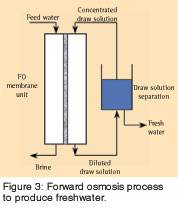 FO has thus drawn much attention with applications developed in various fields such as wastewater treatment, pharmaceutical and juice concentration, desalination, and even power generation and potable-water reuse in space. In view of the technique’s great potential, scientists from the National University of Singapore (NUS) Department of Chemical and Biomolecular Engineering, the Singapore–MIT Alliance, and the Agency for Science, Technology and Research (A*STAR) have been working together to explore the exciting possibilities FO research promises. FO has thus drawn much attention with applications developed in various fields such as wastewater treatment, pharmaceutical and juice concentration, desalination, and even power generation and potable-water reuse in space. In view of the technique’s great potential, scientists from the National University of Singapore (NUS) Department of Chemical and Biomolecular Engineering, the Singapore–MIT Alliance, and the Agency for Science, Technology and Research (A*STAR) have been working together to explore the exciting possibilities FO research promises.
Membrane Distillation
Membrane distillation (MD) combines both membrane technology and evaporation processing in one unit. It involves the transport of water vapour through the pores of hydrophobic membranes via the temperature difference across the membrane. For almost three decades, MD has been considered an alternative approach for conventional desalination technologies such as multistage-flash vaporisation and RO. These two techniques involve high energy and high operating pressure respectively, which result in excessive operating costs if oil prices continuously move up. MD offers the attractiveness of operation at atmosphere pressure and low temperatures (30o – 90oC), with the theoretical ability to achieve 100% salt rejection.
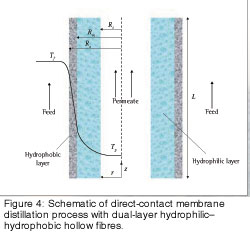 Owing to its low energy requirement, MD coupled with solar energy, geothermal energy, or waste heat can achieve cost and energy efficiency. The Singapore government recently showed its commitment to solar-energy technology by allocating S$170 million towards its research and development. Earlier, the city-state had positioned itself as a global hydrohub to supply up to 5% of the total world water market. The ideal proposition is to combine both MD and solar technology to realise a cheaper and more energy-efficient system for obtaining potable water. Owing to its low energy requirement, MD coupled with solar energy, geothermal energy, or waste heat can achieve cost and energy efficiency. The Singapore government recently showed its commitment to solar-energy technology by allocating S$170 million towards its research and development. Earlier, the city-state had positioned itself as a global hydrohub to supply up to 5% of the total world water market. The ideal proposition is to combine both MD and solar technology to realise a cheaper and more energy-efficient system for obtaining potable water.
However, the industry has not fully embraced MD for several reasons: low water flux (i.e., productivity) and shortage of long-term performance data due to the wetting of the hydrophobic microporous membrane. Materials breakthroughs on new microporous membranes with desired porosity, hydrophobicity, low thermal conductivity, and low fouling are essential to bring MD closer to commercialisation. Opportunities therefore beckon membrane researchers to improve the flux in the process and increase its durability by fabricating highly permeable super-hydrophobic membranes and/or modifying the MD module configurations.
Dual-Layer Hydrophilic-Hydrophobic Hollow Fibres
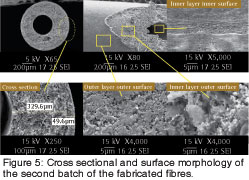 To enhance the flux in an MD process, one possible approach involves utilising hydrophilic–hydrophobic membranes. Minimising the thickness of the hydrophobic functional layer and using a hydrophilic layer as support for the thin functional layer will reduce water vapour mass-transfer resistance through the membrane (Figure 4). To enhance the flux in an MD process, one possible approach involves utilising hydrophilic–hydrophobic membranes. Minimising the thickness of the hydrophobic functional layer and using a hydrophilic layer as support for the thin functional layer will reduce water vapour mass-transfer resistance through the membrane (Figure 4).
For the first time, the team fabricated dual-layer hydrophilic–hydrophobic hollow fibres especially for direct-contact membrane distillation (DCMD) by co-extruding two different physically modified polyvinylidene fluoride (PVDF) solutions. Incorporating hydrophobic particles in the outer-layer dope solution makes the outer thin hydrophobic functional fibre layer. The mixed-matrix functional layer exhibits a greater hydrophobicity with a contact angle of about 140° compared with that made of neat PVDF, which is about 75°. Blending PVDF dope solution with hydrophilic particles and polyacrylonitrile polymer allows the fabrication of the inner hydrophilic support layer, permitting a contact angle as low as 50°.
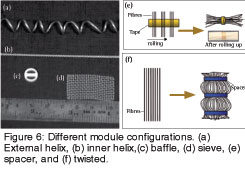 The morphologies of the successfully spun dual-layer fibres (Figure 5) show the achievement of a desirable sponge-like and highly porous structure. The researchers tested the fabricated fibres in a DCMD process to obtain fluxes as high as 55kg/m2hr at 90°C, which is much higher than most existing data published in the open literature. A*STAR and NUS have filed a patent for this invention. The morphologies of the successfully spun dual-layer fibres (Figure 5) show the achievement of a desirable sponge-like and highly porous structure. The researchers tested the fabricated fibres in a DCMD process to obtain fluxes as high as 55kg/m2hr at 90°C, which is much higher than most existing data published in the open literature. A*STAR and NUS have filed a patent for this invention.
Baffled Module Designs
Because of the effect of temperature polarisation (Figure 4) or temperature drop crossing membrane (Tf –Tp), heat transfer across the boundary layer from the bulk to the membrane surface often limits the rate of flux transfer in MD. Thus to improve mass transfer of flux in MD, researchers must minimise this phenomenon. An alternative approach to the flux enhancement in MD application lies in the modification of module design by spacers/baffles/turbulence promoters. Spacers can aid in the increase of both the heat and the mass-transfer coefficients via the generation of turbulence flow, a change in the characteristics of which will enhance boundary-layer heat and mass transfer, resulting in increased flux transfer.
The Singapore researchers employ a series of systematic module configurations in an attempt to enhance the total flux. They have incorporated module designs such as the baffle, external helix, inner helix, and sieve during the process of module fabrication (Figures 6a–d). They have also introduced two special configurations (spacer and twisted modules) (Figures 6e–f) into the module configurations.
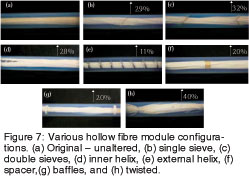 By implementing these different module designs, the investigators observed an 11–49% increase in flux performance at 75oC with respect to the original, unaltered module (Figure 7). It is interesting that the highest flux attained (49% increase) combined two plastic sieves and the inner helix configuration at 75oC. The generation of turbulence, the increase in effective membrane-surface contact, and the effects of cross-flow possibly account for the improvement in MD performance. By implementing these different module designs, the investigators observed an 11–49% increase in flux performance at 75oC with respect to the original, unaltered module (Figure 7). It is interesting that the highest flux attained (49% increase) combined two plastic sieves and the inner helix configuration at 75oC. The generation of turbulence, the increase in effective membrane-surface contact, and the effects of cross-flow possibly account for the improvement in MD performance.
The FO research has received attention from the Public Utilities Board’s (PUB’s) Centre for Advanced Water Technology in Singapore. Negotiations are underway to have a joint project and pilot-scale trials at PUB. A Saudi Arabia university and a Middle Eastern research institute have expressed interest to develop a collaborative research on the MD project, while a US company is looking at licensing FO membrane technologies.
 Click here to download the full issue for USD 6.50 Click here to download the full issue for USD 6.50
|


 ccording to Chemistry: A World of Choices by Paul Kelter, James Carr, and Andrew Scott published in 2003, 97.34% of Earth’s water takes the form of salt water in oceans, seas, and lakes. Desalination, a workable but expensive process, can convert this resource into drinkable water. Given a pressing worldwide water shortage, an urgent need exists for alternative desalination technologies to make available cheap and reliable sources of water for the world’s growing population, as well as to meet its industrial needs. Moreover, research into improved desalination holds many benefits, particularly for Singapore, an island nation with limited freshwater but plenty of seawater.
ccording to Chemistry: A World of Choices by Paul Kelter, James Carr, and Andrew Scott published in 2003, 97.34% of Earth’s water takes the form of salt water in oceans, seas, and lakes. Desalination, a workable but expensive process, can convert this resource into drinkable water. Given a pressing worldwide water shortage, an urgent need exists for alternative desalination technologies to make available cheap and reliable sources of water for the world’s growing population, as well as to meet its industrial needs. Moreover, research into improved desalination holds many benefits, particularly for Singapore, an island nation with limited freshwater but plenty of seawater.
 The term osmosis describes the natural diffusion of water through a semi-permeable membrane from a solution of a lower concentration to a solution with a higher concentration (Figure 1). Like reverse osmosis (RO), forward osmosis (FO) uses a semi-permeable membrane to separate water from dissolved solutes effectively. The semi-permeable membrane acts as a barrier that allows small molecules such as water to pass through while blocking larger molecules like salts, sugars, starches, proteins, viruses, bacteria, and parasites (Figure 2).
The term osmosis describes the natural diffusion of water through a semi-permeable membrane from a solution of a lower concentration to a solution with a higher concentration (Figure 1). Like reverse osmosis (RO), forward osmosis (FO) uses a semi-permeable membrane to separate water from dissolved solutes effectively. The semi-permeable membrane acts as a barrier that allows small molecules such as water to pass through while blocking larger molecules like salts, sugars, starches, proteins, viruses, bacteria, and parasites (Figure 2).
 FO has thus drawn much attention with applications developed in various fields such as wastewater treatment, pharmaceutical and juice concentration, desalination, and even power generation and potable-water reuse in space. In view of the technique’s great potential, scientists from the National University of Singapore (NUS) Department of Chemical and Biomolecular Engineering, the Singapore–MIT Alliance, and the Agency for Science, Technology and Research (A*STAR) have been working together to explore the exciting possibilities FO research promises.
FO has thus drawn much attention with applications developed in various fields such as wastewater treatment, pharmaceutical and juice concentration, desalination, and even power generation and potable-water reuse in space. In view of the technique’s great potential, scientists from the National University of Singapore (NUS) Department of Chemical and Biomolecular Engineering, the Singapore–MIT Alliance, and the Agency for Science, Technology and Research (A*STAR) have been working together to explore the exciting possibilities FO research promises.
 Owing to its low energy requirement, MD coupled with solar energy, geothermal energy, or waste heat can achieve cost and energy efficiency. The Singapore government recently showed its commitment to solar-energy technology by allocating S$170 million towards its research and development. Earlier, the city-state had positioned itself as a global hydrohub to supply up to 5% of the total world water market. The ideal proposition is to combine both MD and solar technology to realise a cheaper and more energy-efficient system for obtaining potable water.
Owing to its low energy requirement, MD coupled with solar energy, geothermal energy, or waste heat can achieve cost and energy efficiency. The Singapore government recently showed its commitment to solar-energy technology by allocating S$170 million towards its research and development. Earlier, the city-state had positioned itself as a global hydrohub to supply up to 5% of the total world water market. The ideal proposition is to combine both MD and solar technology to realise a cheaper and more energy-efficient system for obtaining potable water.
 To enhance the flux in an MD process, one possible approach involves utilising hydrophilic–hydrophobic membranes. Minimising the thickness of the hydrophobic functional layer and using a hydrophilic layer as support for the thin functional layer will reduce water vapour mass-transfer resistance through the membrane (Figure 4).
To enhance the flux in an MD process, one possible approach involves utilising hydrophilic–hydrophobic membranes. Minimising the thickness of the hydrophobic functional layer and using a hydrophilic layer as support for the thin functional layer will reduce water vapour mass-transfer resistance through the membrane (Figure 4).
 The morphologies of the successfully spun dual-layer fibres (Figure 5) show the achievement of a desirable sponge-like and highly porous structure. The researchers tested the fabricated fibres in a DCMD process to obtain fluxes as high as 55kg/m2hr at 90°C, which is much higher than most existing data published in the open literature. A*STAR and NUS have filed a patent for this invention.
The morphologies of the successfully spun dual-layer fibres (Figure 5) show the achievement of a desirable sponge-like and highly porous structure. The researchers tested the fabricated fibres in a DCMD process to obtain fluxes as high as 55kg/m2hr at 90°C, which is much higher than most existing data published in the open literature. A*STAR and NUS have filed a patent for this invention.
 By implementing these different module designs, the investigators observed an 11–49% increase in flux performance at 75oC with respect to the original, unaltered module (Figure 7). It is interesting that the highest flux attained (49% increase) combined two plastic sieves and the inner helix configuration at 75oC. The generation of turbulence, the increase in effective membrane-surface contact, and the effects of cross-flow possibly account for the improvement in MD performance.
By implementing these different module designs, the investigators observed an 11–49% increase in flux performance at 75oC with respect to the original, unaltered module (Figure 7). It is interesting that the highest flux attained (49% increase) combined two plastic sieves and the inner helix configuration at 75oC. The generation of turbulence, the increase in effective membrane-surface contact, and the effects of cross-flow possibly account for the improvement in MD performance.
 Click here to download the full issue for USD 6.50
Click here to download the full issue for USD 6.50